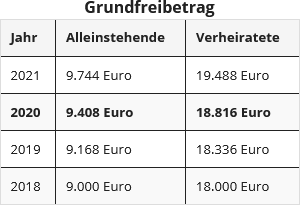Which allowances can pensioners use?
Pensioners who file an income tax return can enter various allowances and expenses incurred and thus reduce their taxable income.
The personal pension allowance
The pension allowance is determined in the second full year of pension receipt. In the year of the pension start and in the second pension reference year, the pension is taxed with the so-called taxation share. The remaining amount in the second year is the personal pension allowance, which then remains tax-free throughout life. From the third year, the pension is taxable in full after deduction of the personal pension allowance and the income-related expenses allowance of 102 Euro.
The pension allowance for civil servants
Like the retirement allowance (Rentenfreibetrag), the pension allowance (Versorgungsfreibetrag) will decrease to zero percent by the year 2040. However, the pension allowance only applies to pensions and company pensions from direct commitments and from support funds. In addition, pensioners receive a supplement to the pension allowance. This supplement also decreases over time.
This is how the figures look at the start of the pension in 2014:
- The pension allowance is 25,6 percent, up to a maximum of 1.920 Euro.
- The supplement to the pension allowance is 576 Euro.
- In addition, the allowance for income-related expenses of 102 Euro is deducted.
- In total, 2.598 Euro of pension payments remain tax-free - for life.
The old-age tax allowance
The old-age tax allowance can be used by pensioners or retirees who receive additional income or wages in addition to their pension. Additional income includes, for example, income from renting, capital assets, self-employment, private sales transactions or Riester pensions. Before this, however, the tax office deducts various amounts (savings allowance, income-related expenses). The amount of the old-age tax allowance depends on the year of birth of the pensioner.
This is how the figures look when the retiree reaches the age of 64 in 2013:
- As of 2014, the old-age tax allowance amounts to 25,6 percent for life, up to a maximum of 1.216 Euro.
The income-related expenses allowance
Every taxpayer receives a flat-rate income-related expenses allowance of 102 Euro per year for their pension or annuity.
Special expenses
Contributions to statutory health and nursing care insurance can also be entered by pensioners as special expenses in the "Form Pension Expenses" (Anlage Vorsorgeaufwand). Pensioners receive a health insurance subsidy from their pension insurance provider by which the contributions are to be reduced. Donations are tax-deductible as special expenses. The collected donation receipts thus reduce the taxable income. If you do not donate or have no other special expenses, the tax office deducts an allowance of 36 Euro.
Exceptional costs
Elderly and sick people in particular incur exceptional costs that can reduce their taxable income. Whether it is accommodation in a nursing home, the employment of a domestic helper or a contract with a tradesman. But pensioners can also claim medical expenses such as medication, glasses or dentures.
The mini-job
If a pensioner (over 65 years of age) has a 450-euro job, this income is tax-free for him.
Tip: If, as a pensioner, you remain below the basic tax allowance with the various tax-free allowances, flat rates and deductible expenses, then you also do not have to pay tax on your income.
